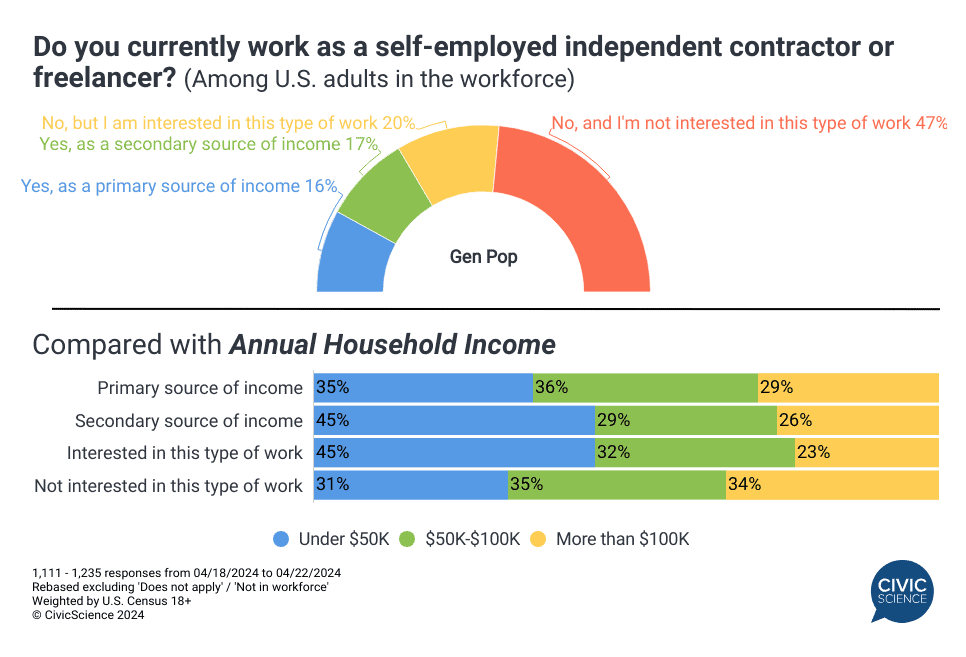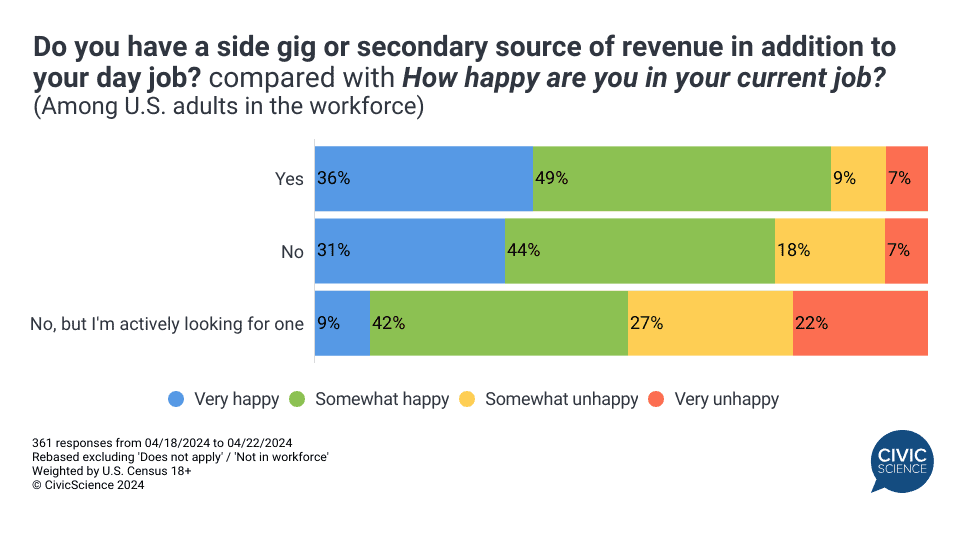Americans are facing more financial stress now than ever. Recent CivicScience data show that 80% of U.S. adults say they have at least one source of financial stress, with 30% citing ‘managing living expenses’ as their biggest financial stressor, followed by ‘managing debt’ and ‘saving and investing.’*
Those sentiments are echoed by a recent CNBC survey which found a lack of savings, inflation, and economic instability were the driving forces behind an estimated 70% of Americans feeling stressed about their finances. With so many people dealing with increased financial stress, it’s unsurprising that many are turning toward additional or alternative ways to earn income, such as holding multiple jobs, side hustles, freelance and gig work, and independent contracting.
Take Our Poll: Have you ever considered starting a side hustle?
Employment reporting from the U.S. Labor Department has shown the number of Americans who hold a part-time job in addition to a full-time position has been on the rise, reaching nearly 5 million by Q4 of 2023. CivicScience data show a marginal increase from 2021 to 2024 in those securing a secondary source of revenue in addition to their primary jobs.
In 2021, a notable 22% of U.S. adults in the workforce were juggling a secondary source of income. Fast-forward to 2024, and that number has crept up to 26%. It’s not just the numbers that are telling, but also the stories behind them. More people are actively seeking side gigs or secondary sources of income in 2024, as evidenced by a 20% increase over this period. However, it’s worth noting that a significant majority (56%) still rely solely on their primary income.

What Kind of Side Work Are People Doing?
When it comes to freelance or contractor positions such as freelance writing, accounting, consulting, and gig work with companies like Uber, DoorDash, and Lyft, new CivicScience polling finds that 17% of Americans in the workforce hold these types of self-employed positions as a secondary source of income. An additional 16% confirm that freelancing or contracting is their primary source of income.
Although working independently might not be everyone’s cup of tea, there is a relatively strong interest – 20% of those not currently working as freelancers or independent contractors are interested in this type of work.
Findings also indicated that 45% of those who have self-employed side hustles as a secondary source of income earn less than $50K yearly, compared to 35% of those who are primarily self-employed and 31% of those who aren’t interested in self-employed work. So, it seems that those who undertake a self-employed side hustle are more inclined to earn less on average.

In addition, 45% of those interested in self-employed work are also lower-income earners possibly looking to supplement their income, although interest spans across all income levels.
Join the Conversation: Do you need a “side hustle” to make your desired income?
Job Happiness, Financial Stress and Employment Status Insights
According to past CivicScience data, those who have a side hustle tend to be happier with their jobs, and current data show that continues to be the case. A total of 85% of those who have a secondary income stream are at least ‘somewhat’ happy with their current employment, compared to 75% of those without a second job and 51% of those who are looking for side work.

This could be because they encounter less financial stress with added income. However, nuances exist – data also show job happiness is lower among those who have self-employed secondary jobs, such as gig work, and is higher among those who are primarily self-employed and full-time employed workers. Interestingly, there are a few key insights regarding financial stress among those who are self-employed as gig workers and freelancers:
- Managing living expenses is the top source of financial stress for people with self-employed side gigs and freelance work, whereas debt management is the biggest pain point for those who earn their primary income through freelancing and contracting.
- Saving and investing or planning for the future is much more of a financial stressor among people who do not have self-employed work, and these workers are the least likely to say they have financial stress.
- People who are interested in a side hustle are likely looking to supplement meeting basic living expenses, but improving their credit score could be another reason they want to take on additional work.
Interest in side hustles is on the rise – if only marginally – especially as financial stressors continue to pose a problem in the U.S. Lower-income earners seem slightly more likely to embrace freelancing as a primary or secondary source of income, but high-income earners aren’t far behind. This is especially the case with those who need to manage debt and living expenses.
However, the data from a historical perspective suggest that the strong percentage of Americans who hold multiple jobs or participate in self-employed work as a side hustle is unlikely to decline. Time will tell if a cooling labor market will change that.
Stay on top of these and other labor market trends in real-time with the CivicScience InsightStore™. Learn how clients can benefit from our database of over 500K questions and 4+ million daily responses – get in touch to see it in action.
*n=1,878 responses from 01/23/2024 to 02/04/2024


